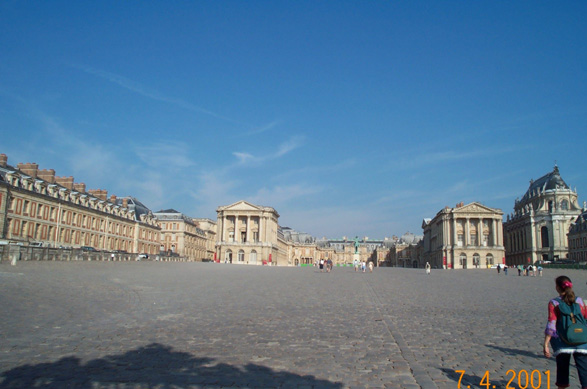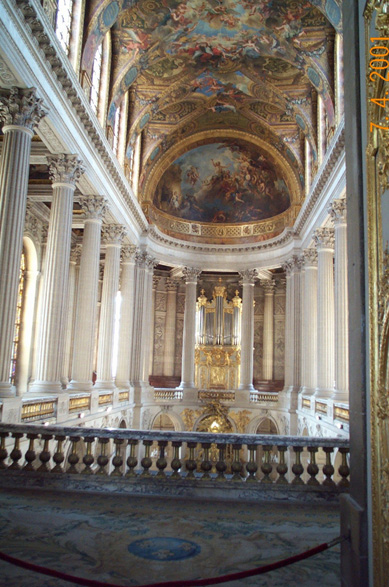
Versailles, France
July 3-4, 2001
Versailles is, of course, the location of the most famous château in France, and where the treaty was signed that ended World War I. It was started by Louis XIII in 16th century and was just a shack. It was Louis XIV who built it into what it is today. Mindful of his stature as one of the premier kings in the world, and stuck with an enormous ego, he decided he needed a palace befitting his stature. So Versailles was built into one of the most ornate and wealthy showcases in the world, or at least of anything I've ever seen. It was the seat of the French government from 1682 until 1796 when the French Revolution started. It took 30,000 workers to build it, and the cost drained the finances of the kingdom, sowing the seeds for the Revolution. It was the place from which Louis XVI and Marie Antoinette escaped when the rebels came for them. They were later caught, brought back to Paris, and, as we all know, beheaded. Versailles was big enough to hold the King and his court, which numbered around 6000 people. Versailles was also open to the public back then, and often times had close to 10,000 people in it. The Palace also has a huge garden, and forests that are famous for the geometric layout of the trees.
The main architect of the place was some guy named Louis Le Vau, who was succeeded by Jules Hardouin-Mansart. The chief painter and interior designer was Chares Le Brun. The landscape artist was André Le Nôtre. So you have these guys to thank for all the beauty.
Now, on with the pictures !
This first picture is of the whole palace as you come walking up. It has hard to capture the grandeur of place with a little digital camera, but this is the place. We arrived around 9:15 am and were able to walk right up and get a ticket. The tour itself was crowded, but once we finished and walked back outside the line for tickets to get in came all the way back to where I was standing when I took the picture. So if you're going to visit, go early or go late. Most of the famous rooms are in the buildings in the center-rear of the picture.

These next two pictures try to show how ornate and fancy the place is. We don't have anything like this in the U.S., at least that I know of. The first picture is of the chapel where all the Louis' and Napoleon would do the religious thing. It's one of the first things you see, setting the tone for the rest of the tour. The second picture is of the ceiling, ornate cornice work, and extensive use of marble in the palace. The third picture is another ceiling shot.

One of the most famous rooms in the palace is the Hall of Mirrors. It is a 72m long hall with nothing but marble columns and large mirrors on one side, and windows overlooking the gardens and canals on the other side. Mirrors, especially in the sizes used here, where very scarce and very expensive back in Louis' day. Here is Jeff in front of one set of mirrors. He smiled, but I think he really wanted to get out of there. The second picture is of me, Steve, standing in front of the mirrors taking a picture of myself standing in front of the mirrors. That's our friend Larry standing on the right, which would have been my left at the time. The third picture is of the usual band of suspects, except for Jeff, who was probably looking for the nearest escape. At least he stayed on this side of all the barriers, unlike at Fountainbleu.
Last Updated July 15, 2001 12:26 CET